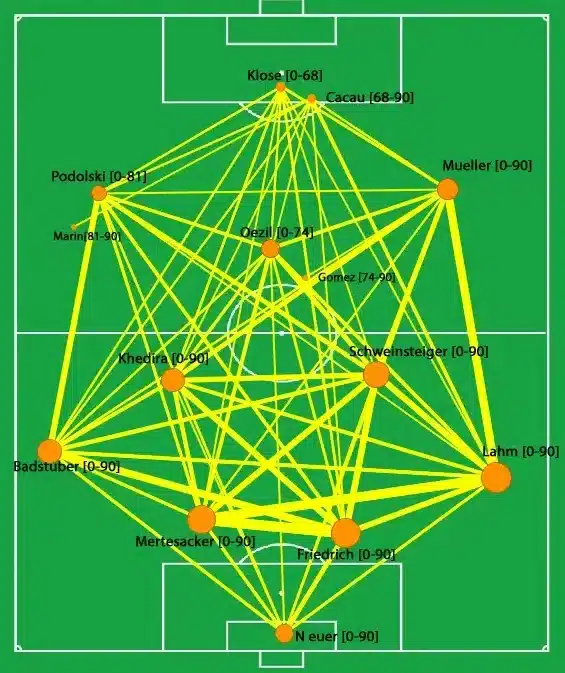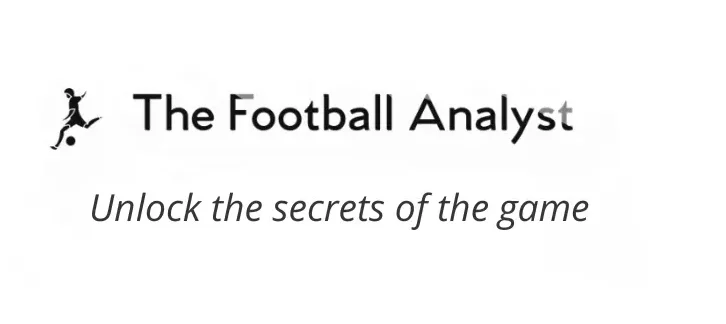In modern football, visuals and data have become essential for anyone looking to understand the game on a deeper level. One of the most effective tools for tactical analysis is pass networks. This visualization method goes beyond simple statistics and reveals how players interact, how a team builds its structure in possession, and where influence lies on the pitch.
In this article, we’ll break down what pass networks are, how they’re built, and most importantly, what they can reveal about team structure and playing style.
What Is a Pass Network?
A pass network is a visual representation of how players connect through passes over a period of time—usually a single match. Each player appears as a dot (or node) placed roughly in their average on-ball position. Lines link players who pass to each other, with line thickness reflecting how often those passes occur. In many visualizations, player nodes are sized according to how involved they are—larger nodes for players who receive the ball more often.
As a result, you don’t just see who passed to whom—you get a snapshot of the team’s shape, balance, and flow in possession.

How Are Pass Networks Built?
To build a pass network, analysts typically follow a series of steps:
- Collect passing data – This includes who passed the ball, who received it, and where on the pitch it happened.
- Map average positions – Instead of using static formation spots, analysts calculate each player’s average location when receiving the ball. This better reflects real positional behavior.
- Draw connections – Players who pass to one another are connected by lines, with frequency represented by line thickness. In some cases, arrows indicate direction.
- Apply filters – Analysts can refine the network to show certain zones (e.g., final third), specific halves, or match phases. This allows for focused tactical insights.
Therefore, pass networks provide not just a visual, but a context-aware tactical map of how a team operates in possession.
What Pass Networks Reveal
1. Team Shape in Possession
First and foremost, pass networks clearly reflect a team’s shape when in possession. While line-up graphics might list a team as playing in a 1-4-3-3, a pass network might show a 1-3-2-5 or 1-2-3-5 structure due to the roles players take up during build-up. For example, a fullback may tuck inside while a midfielder pushes higher, creating a new structural identity.
Thus, pass networks help you understand a team’s real positional behavior, not just their nominal formation.
2. Key Connectors and Central Figures
Pass networks also highlight which players act as the team’s main connectors. These are often midfielders or defenders who keep possession flowing and link different areas of the pitch. Players like Rodri, Toni Kroos, or Frenkie de Jong frequently appear at the heart of these networks.
Even if these players don’t lead in assists or goals, their value becomes evident through their central position and multiple connections. In short, pass networks help identify players who dictate tempo and structure.
3. Preferred Passing Routes
In addition, pass networks reveal which areas of the pitch a team uses most frequently. A thick connection between the left-back and left winger might suggest a left-sided overload. Alternatively, a strong vertical link between centre-backs and forwards might indicate a more direct approach.
This information allows analysts and coaches to spot patterns, strengths, and potentially predictable habits.
4. Compactness and Spacing
Another insight pass networks provide is how compact or stretched a team is during possession. If the nodes are tightly grouped, the team likely values close support, combination play, and short passing. On the other hand, if players are spaced far apart, the team might prefer width, direct passing, or might simply lack cohesion.
Therefore, spacing patterns help coaches evaluate whether a team is structurally sound or vulnerable to pressure.
5. Tactical Asymmetry
Modern teams rarely play symmetrically. One fullback might push high while the other tucks inside; one winger may hug the touchline while the other drifts into central areas. Pass networks reveal these asymmetries clearly.
For instance, if one side of the pitch shows frequent connections and dense passing, while the other is sparse, this likely reflects a tactical strategy rather than coincidence. Consequently, opponents can use this information to exploit imbalances or plan countermeasures.
Limitations of Pass Networks
Despite their strengths, pass networks have limitations. They offer structure and relationships, but not every detail:
- They don’t show off-ball movement – A winger making constant decoy runs might not feature prominently, even if they create vital space.
- They don’t measure pass quality – A player might complete many sideways or safe passes without progressing the ball.
- They ignore defensive pressure – You won’t see whether a pass occurred under intense pressing or in space.
- They flatten the match into a snapshot – Football is dynamic; pass networks simplify and summarize it.
Therefore, while pass networks are powerful, they work best when combined with other tools such as video, heatmaps, and advanced metrics like expected threat (xT).
Why Pass Networks Matter
Pass networks help us view football as a connected system. They visualize how players interact, how structure shapes movement, and how teams construct their possession strategy. By doing so, they uncover truths that typical match stats or player ratings often miss.
Moreover, coaches can use them to reinforce or question their tactical setup. Scouts can spot players who influence the game in subtle ways. And analysts can use them to compare matches or track how a team evolves over time.
Final Thoughts
Football isn’t just about moments of individual brilliance — it’s about how players combine. Pass networks capture that collective behavior. They show how structure creates style, and how connections build identity.
In conclusion, pass networks don’t tell the whole story, but they help you ask smarter questions and spot meaningful patterns. For anyone serious about football analysis, they’re a vital part of the toolkit — clear, visual, and full of insight.
